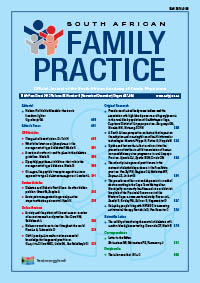The gradual loss of vision
Keywords:
Gradual loss of vision, cataracts, refractive error, optic atrophy, glaucoma, age-related macular degeneration
Abstract
Gradual loss of vision is a clinical problem that is encountered fairly regularly in most primary healthcare settings. Patients present with chronic, slowly progressive and generally painless visual loss. The reduction in vision is usually bilateral, though frequently asymmetrical, and occurs over weeks to years. A goal-directed assessment of the patient presenting with gradual loss of vision is required. A history of the type of visual loss, e.g. central or peripheral, and whether it is worse for near vision or distance vision, is helpful. The examination should focus on visual acuity, confrontation visual field testing, pupil testing for the presence of an afferent pupil defect and assessment of the red reflex and fundoscopy. The more common conditions that cause gradual loss of vision can be divided into two groups based on the reversibility of the visual loss. Cataracts, refractive error, corneal blindness and early diabetic macular oedema are generally reversible. Optic atrophy, glaucoma, retinal degeneration and age-related macular degeneration usually cause permanent loss of vision. Most of these conditions are briefly discussed in this article. This has been performed at a level that is suitable to primary care.
Published
2013-08-01
Section
CPD
By submitting manuscripts to SAFP, authors of original articles are assigning copyright to the South African Academy of Family Physicians. Copyright of review articles are assigned to the Publisher, Medpharm Publications (Pty) Ltd, unless otherwise specified. Authors may use their own work after publication without written permission, provided they acknowledge the original source. Individuals and academic institutions may freely copy and distribute articles published in SAFP for educational and research purposes without obtaining permission.

